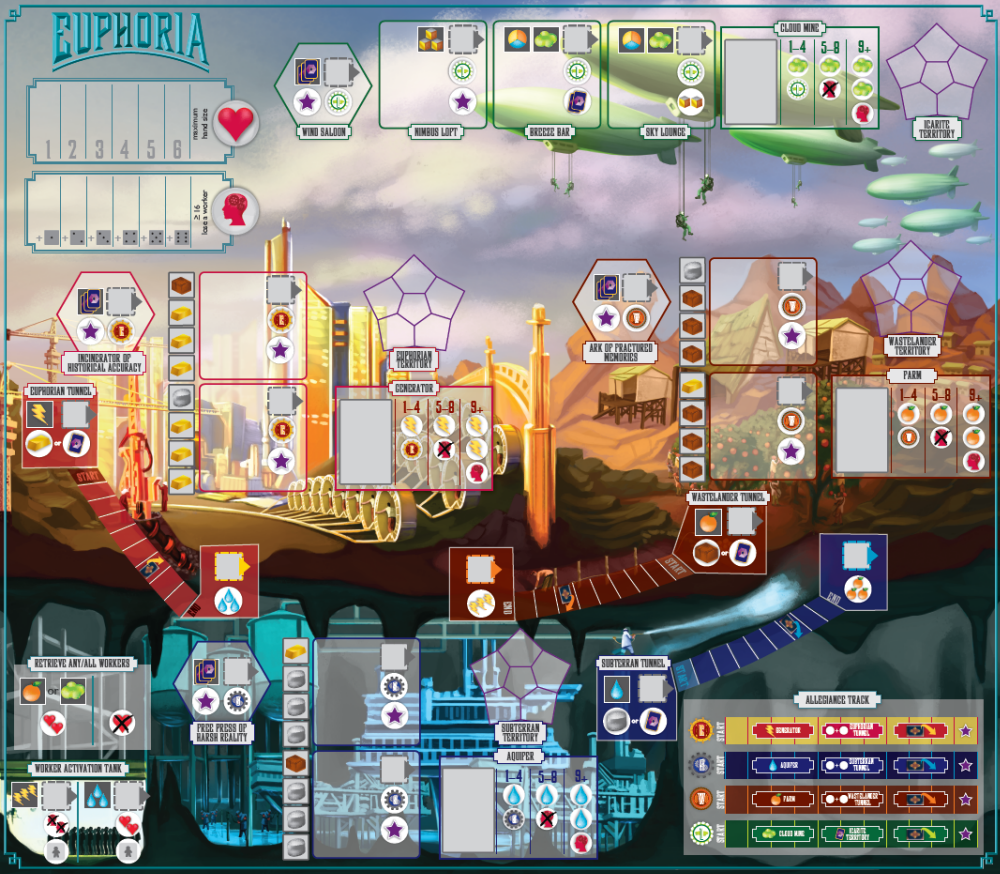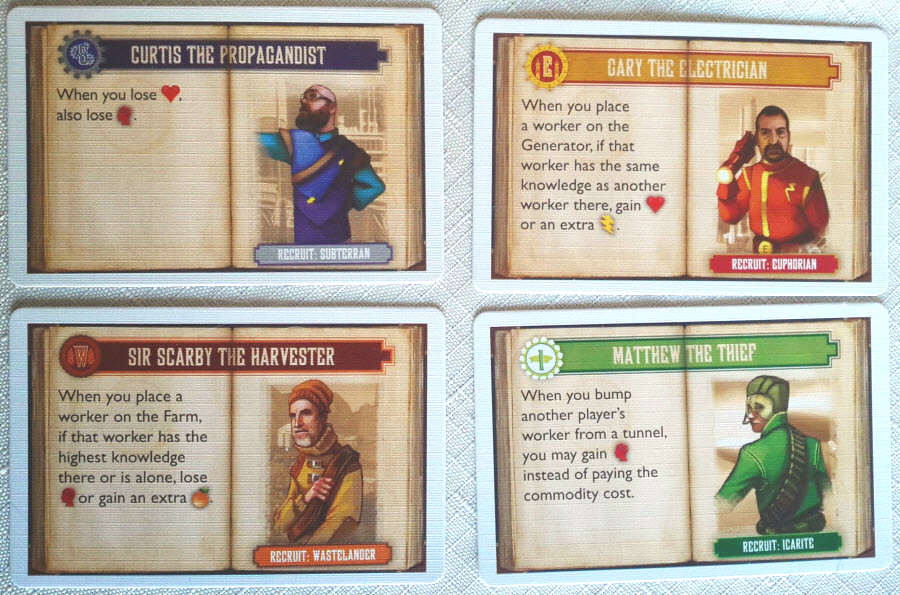The loudspeaker crackles to life above your head: REMINDER: ALL WORKERS MUST REMAIN IN THEIR DESIGNATED SECTOR. ATTEMPTING TO LEAVE YOUR SECTOR WILL RESULT IN APPREHENSION BY THE MINISTRY OF SEVERE RE-EDUCATION.
You dig faster. Somewhere below you, the Subterrans have blasted a hole in the wall surrounding Euphoria and they’re selling tickets out…if you can get there.
REMINDER: ALL WORKERS MUST TAKE THEIR REGULAR BLISS SUPPLEMENTS. FAILURE TO COMPLY WILL RESULT IN UTTER DESPAIR AND PUNISHMENT.
Your shovel breaks through the top of a Subterran tunnel and you fall the eight feet to the dirt floor. A group of workers is passing by, but you can tell by their smiles that they’re too Bliss’d out to notice things they shouldn’t. Keep ’em happy; keep ’em stupid.
NOTICE: A FESTIVE BOOK BURNING WILL BE HELD AT 7 PM IN ALL MAJOR SECTOR SQUARES. THOSE WHO DO NOT WISH TO ATTEND WILL BE CONSIDERED TRAITORS OF THE STATE.
Down one tunnel, up another. Back and forth so many times that you don’t know which way is which. Then you find it – a little nook off a little alley off a little throughway. Freedom. Escape.
But something is off. The men standing at either side of the tunnel aren’t Subterrans. They’re guards. A woman in a long white coat steps out into view.
“Subject completed the maze in just over three hours. This is most unsatisfactory. Guard, return him to my lab. We’re going to up his dose . . .”
The Premise
At some undetermined point in the future, the world as it exists ends, probably through something self-inflicted event. From its ashes rose the perfect city with the perfect society. It was called Euphoria. And it was all a big lie. The truth is that Euphoria is this information has been redacted by the Euphorian Upstanding Citizens Council.
The Rules
Euphoria is a dystopian clash between four competing factions. Setup is fairly quick but requires some marginal effort with all of the game’s resources, cards, and tracking components. The board is broken down into four sections, one for faction: the Euphorians, Subterrans, Wastelanders, and Icarites. Each faction is associated a basic resource (such as Water for Subterrans) and a more advanced resource (such as Gold for Euphorians), except for the Icarites who only have one. Artifact cards also exist as faction-neutral resources.
To begin, each player receives a set of ten Authority Tokens, a pair of dice workers, and an Ethical Dilemma card that doubles as a reference sheet. Players roll their worker dice to determine the starting player, with the highest roller going first.
In addition, each player receives four Recruit cards, of which two are kept. Each Recruit card is aligned with one of the game’s factions and provides the player with unique abilities. One Recruit card is chosen to be active at the beginning of the game, while the other remains secret until the conditions are met to reveal it.
Besides action spaces, the board also contains three player tracks: Morale, Knowledge, and Allegiances. Morale denotes a player’s hand size, while Knowledge affects the chances of a player going over a dice total of 15 in their worker pool and losing units. The Allegiance track bestows bonuses on players with a face-up Recruit of that faction, such as getting additional resources.
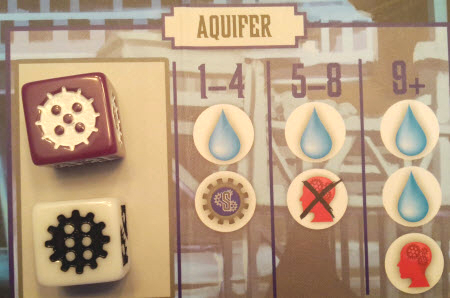
This multi-use space total is 11, giving White two Water and raises their Knowledge by one.
On each player’s turn, they take one of two possible actions: Place a Worker, or Retrieve Workers. To place a worker, the player selects one of their available dice workers (or multiple workers if they share the same die result) and puts them on an available action space.
Action spaces come in three forms. Single-use spaces usually require an activation cost and can only be used by one worker at a time, but any player may “bump” that worker back to its owner and take the space instead. Multi-use spaces may contain any number of workers, but the action’s reward changes depending on the combined total of all workers present. One-time use spaces, used in the creation of Markets, also require an activation cost but do not provide a reward for using them. Instead, Markets require between two and four dice workers on spaces to be completed, providing a reward at that point.
To Retrieve Workers, the player simply pays one of the two possible retrieval costs and takes back as many of their workers off the board as they choose.
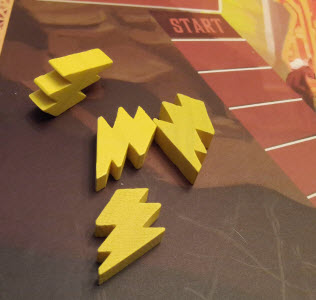
Oppression requires energy!
While most actions in Euphoria consist of gathering or exchanging resources, the objective is to place Authority tokens. This is done in a number of ways, including through special territory-based action spaces, helping to complete Markets, turning in the Ethical Dilemma card, or completing the various Allegiance tracks.
The first player to place ten Authority tokens effectively takes control of the game’s dystopian setting. Whether that player decides to continue the ruse or expose the lies is up to them, but the future of Euphoria is now in their hands.
Everyone else better hope that player is more benevolent than their predecessor.
An Icarite Travel Agency
Traditionally, Worker Placement games tend to be lumped together as largely interchangeable, and it’s understandable to see why. Most worker placement games use the same basic premise of having a set number of units (workers, farmers, merchants, etc.), and players take turns putting those units on spaces to take specific actions. With many Euro-style worker placements this doesn’t deviate all that much, causing some to feel that worker placement games are essentially all the same.
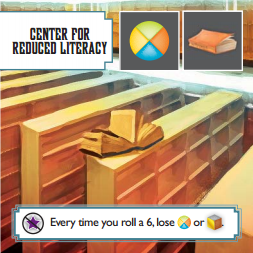
Come for the punch. Stay for the book burning.
Euphoria, however, is not another worker placement clone. Just like how other board game genres continue to evolve, Euphoria sets itself apart from other worker placement games by deviating from the norm in a few aspects.
The most apparent of these is its focus on theme. Euphoria has an incredibly rich and resonant theme. Almost every facet of the game is somehow tied into the game’s bleak futuristic worldview. Whether you’re visiting markets such as the Center for Reduced Literacy, trying to score some sweet Icarite Bliss, or you’re using Subterrans to tunnel into the Wastelander territory for better access to Food, the game rewards players with an exceptional blend of flavor and mechanics that compliment each other throughout. As a result, Euphoria will likely appeal to Immersionists with its fairly detailed setting – a rather uncommon trait for a worker placement game.
Euphoria’s theme is further reinforced through your Recruit cards. Recruits not only provides you with powerful abilities, but they also set up your identity for the game, letting you decide which faction(s) to represent. This is especially visible in the Allegiance track, where players build up their resources and VP in a way that conveys a sense of purpose and progression – a fact that Architects will enjoy. What’s more, the Recruits ensure that not everyone will be after the same resources the entire game, avoiding bottlenecks and keeping the competition for resources balanced.
Not all Recruits are created equal, however. Most Recruits are comparable with one another, but there are a notable few that scale a little above the curve, either by themselves or when paired with others. On such occasions, the Recruits can swing a player’s odds more in their favor. That said, it’s more the exception than the rule and is something bound to happen with 48 different Recruit cards.
The Fluidity of Euphorian Knowledge
Euphoria’s other major deviation from standard worker placement games is the use of dice worker allocation. This is played up in a couple ways. First, having the die results represent a worker’s knowledge of their surroundings plays nicely into the dystopian theme. With a finite Knowledge cap, should you have too many workers standing around with high knowledge values, they get wise to their situation and run away, resulting in the player temporarily losing a worker die. Thus, you’re often striving to keep your Morale track high and your Knowledge track low. (Keep ’em happy; keep ’em stupid.) Euphoria does a fantastic job incorporating this mechanic with the game’s flavor. Indeed, Euphoria shines brightest in how it utilizes its dice on multiple levels.
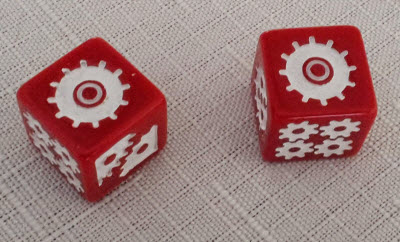
A game where snake eyes is a good thing.
Secondly, there is the doubles rule, where a player with two or more workers with the same die number can place them at the same time. For some this will be a frustrating aspect, as this is entirely based on luck, and worker placement games generally downplay luck. This can be mitigated by getting more workers, but that comes with its own set of risks.
More importantly than the rewarding experience, however, is that utilizing doubles also serves as a convenient catch-up mechanic, making it more of a defensive than offensive bonus. Aside from placing multiple workers to fill up a Market construction site and blocking another player from initially getting in on it, there really isn’t much in the way of stopping another player from taking actions. For a player currently behind the frontrunner, though, getting doubles is a way they may be able to shorten the lead. Admittedly, this luck-based factor is far less useful for the player already winning, but in a close game it could be the factor in who crosses the finish line first.
Only the most stringent-minded strategy planners will find Euphoria’s slightly elevated luck aspect to be problematic. For most Tacticians, there isn’t enough randomness present to make them feel frustrated; you’re still able to work towards your goals without much interference. The lack of a consistent means to thwart or obstruct other players will generate some classic dystopian despair with Strikers, though. Unsurprisingly, they may not find this to be their kind of worker placement game.
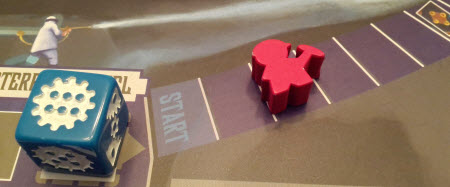
“Working in the tunnels; All day long; Dig, dig, dig; While we sing this song…”
More telling is how Daredevils respond to Euphoria. This group normally avoids worker placement games, but lure of chancing dice rolls and running into the Knowledge cap, coupled with the manageable play time, may be enough for them to actually give this game a try.
A Wastelander Historical Report
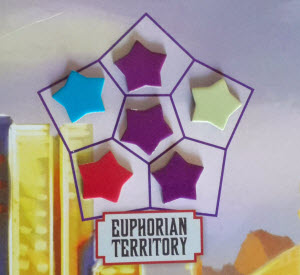
Purple has three Authority Tokens in this territory.
Dice aside, Euphoria still has plenty of worker placement traits you’d expect to see. Like most games of its kind, Euphoria allows for multiple paths to authorize your way to victory, giving it a decent replay value. Whether it’s by racing to max out your Recruit’s factions or making heavy use of Artifact spaces, players have a number of ways to win – and to pivot should one avenue get cut off.
Once you know that you’re doing, that is. Euphoria does have a slight learning curve. Moreover, the game board, while very visually appealing, is also a bit busy for newer players and can add to that initial overwhelming sensation.
Luckily, the game flows in such a way that most catch on fairly quickly, and even if an early playthrough doesn’t work in your favor, Euphoria won’t force you to languish (which we can’t say for the citizens of that world), as the run time is around an hour. This remains pretty accurate regardless of the number of people at the table since Euphoria scales quite well, although the game seems to hit its stride best with 4-6. That being said, Socializers eschew games like this, and that won’t change here. As inviting as Euphoria’ conformist utopia may seem, it still won’t be the right setting for them due to high degrees of decision-making and a lack of player interaction.
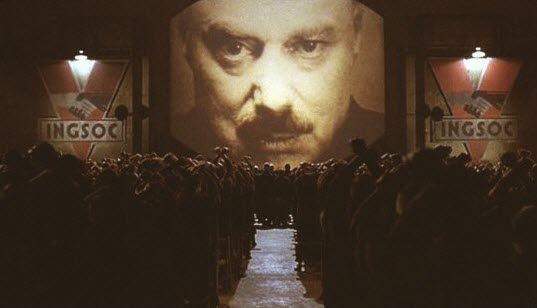
Euphorian studies have shown that thinking too much is bad for you. Try to do less each day.
The Takeaway
While the land of Euphoria may not be the most ideal to live in, visiting it is a rewarding experience. Euphoria’s heavy investment in mixing thematic elements and mechanics pays off well here, letting players perform tasks that make sense on both levels. Its use of dice allocation is the hallmark example of this, blending the concept of workers gaining knowledge of their situation with the need to take orders and progress through the game. Admittedly, the use of dice and various Recruits in Euphoria makes the game slightly more random than some would prefer in their worker placements games, but not holding firm to the classic Euro mold actually helps set Euphoria apart as something more identifiably unique. Euphoria scales well with player size without adding complexity or time to the equation while still keeping players in a close contest for the hearts and minds of its citizens, ultimately making for a great middle-weight worker placement game.
Euphoria is a product of Stonemaier Games.
Cardboard Republic Snapshot Scoring (Based on scale of 5):
Artwork: 4.5
Rules Clarity: 4.5
Replay Value: 4.5
Physical Quality: 4
Overall Score: 4.5
Photo Credits: Euphoria board by Stonemaier Games; 1984 screen by MGM Studios.

